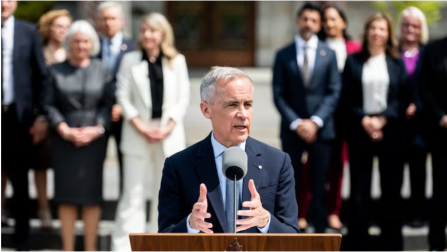
22 May 2025
Last week, Canada’s newly elected prime minister Mark Carney announced his revamped cabinet and emphasized an ‘all of the above’ energy outlook for Canada’s future, which includes building clean energy infrastructure, investing in carbon capture and storage and making Canada an ‘energy superpower’. His cabinet picks for energy and environment signal a balanced approach that blends environmental stewardship with economic pragmatism. But what does this vision mean for Canada’s clean economy?
Carney’s cabinet included a mixture of fresh faces and experienced voices, thirteen of which served as former ministers under the Trudeau leadership. When announcing the cabinet, Carney argued that the cabinet strikes the right balance between new perspectives and experienced voices.
Carney also aims to strike a balance between building a clean economy and investing in Canada’s conventional energy resources. His party’s platform was largely applauded by advocates of the clean economic transition, as it promised strengthening Canada’s critical minerals sector, funding east-west electrical grid expansion, and implementing a range of investment tax credits that support clean energy and technology.
The platform also included a desire to improve Canada’s large-emitter trading systems and develop a Carbon Border Adjustment Mechanism (CBAM), which could prove crucial to protecting Canadian exports when the EU’s CBAM releases in 2026.
However, as Carney stated mere hours after his cabinet announcement, the government will be focusing on all forms of energy including oil and gas, and nuclear development.
“We need to do multiple things at the same time in order to build this base so that we are creating wealth and competitiveness, better lives for Canadians for generations. So we’re going to be very ambitious across a range. That’s why we’re not asking for one nation-building project. We’re asking for nation-building projects, and we are going to move as rapidly as possible on as many of them as possible.”
Carney’s cabinet picks reflect this balance
In the environment portfolio, newly appointed Minster of Environment & Climate Change, Julie Dabrusin has previously held parliamentary secretary positions under both the environment and natural resources files. Dabrusin, a former litigator and community advocate, is in favor of lowering emissions and building a clean economy. In her time as parliamentary secretary to former Environment Minister Stephen Guilbeault, Dabrusin worked on modernizing the Canadian Environmental Protection Act to ban single-use plastics and build a circular economy. She was recently honored with a Clean50 award, for her work championing legislation on electric vehicles and transitioning to a low-carbon economy.
While Dabrusin could be viewed as a mere continuation of the last session’s environment portfolio, Carney’s choice for Energy and Natural Resources Minister reflects a change. Tim Hodgson, first-time MP and former Goldman Sachs Canada CEO, will be taking the helm on the energy portfolio. Hodgson brings with him a wide range of experience in the energy and utilities sectors, with board roles on Ontario power utility firm Hydro One and Calgary oil sands producer MEG Energy. Hodgson has also served as a special advisor to Carney during his tenure as Governor of Bank of Canada.
The appointment of Hodgson and the insertion of ‘Energy’ to his title (formerly this position was only Minister of Natural Resources) signals a refocusing of the portfolio and this government’s approach to a clean economy. Hodgson’s ties to Alberta’s oil sector may act as a much-needed bridge between Ottawa’s priorities and the West’s needs.
Building new markets and opportunities for transatlantic partnerships
Carney’s cabinet picks may also provide opportunities for expanded transatlantic partnerships. In addition to investing energy infrastructure, we also see a commitment to building new markets and expanding Canada’s energy trade with international allies.
With a familiar face in a new role, Germans may be keen to see former Foreign Minister Mélanie Joly in the industry portfolio. This reshuffling reflects the importance of international partnerships for Canada’s industries. It also signals Carney’s aim to diversify the trade infrastructure and enable new clean economic alliances between Canada and Europe.
Similar to the Canada-Germany Hydrogen Alliance signed back in 2022, The Clean Economy Bridge hopes to see more of a focus on introducing new clean economic partnerships between the two countries.
Carney’s cabinet picks aim to balance clean economy ambitions with the realities of traditional energy needs
The appointments of Julie Dabrusin and Tim Hodgson highlight a nuanced approach, combining environmental stewardship with pragmatic energy development. It will be important to see, in the coming months, how this duo responds to the complex challenges of the energy transition, strengthen Canada’s global competitiveness and enhance the global clean economy.

